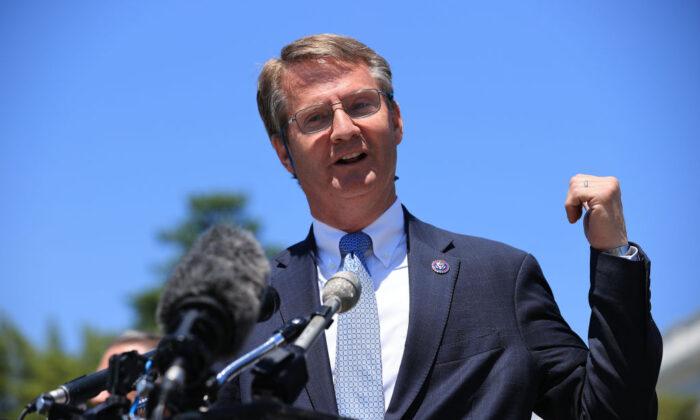House Speaker Mike Johnson (R-La.) floated the idea of a “laddered” continuing resolution (CR), a novel idea for avoiding a potential government shutdown on Nov. 17, when the 45-day stop-gap funding law expires.
“Potentially, you would do a CR that extends individual pieces of the appropriations process, individual bills,” Mr. Johnson said at a Nov. 2 press conference.
The idea could be a lifesaver for the newly elected speaker, who could soon find himself between the same rock and hard place that crushed his predecessor: the choice between allowing the government to shut down for lack of funding and passing a stop-gap spending bill.
In his first full week as speaker, Mr. Johnson is racing to complete the 12 spending bills required by law before the Nov. 17 deadline. When that’s complete, discrepancies between the two sets of bills must be ironed out between the two chambers.
That’s not going to happen by Nov. 17, according to Mr. Johnson.
“We’ve run out of clock on this,” he said.
The clock already ran out once.
As the fiscal year came to a close on Sept. 30, none of the 12 spending bills were signed into law. In the final moments before midnight, then-Speaker Kevin McCarthy (R-Calif.) presented a 45-day stop-gap funding bill, which was passed with bipartisan support in both the House and the Senate.
That cost Mr. McCarthy his job as eight Republicans organized his ouster for what they saw as a collaboration with Democrats and an extension of the Biden administration’s spending plan.
With time running out again, Mr. Johnson had hoped to pass a second, longer-term stop-gap funding bill that would cover government spending into the new year.
“My initial idea was to extend that to January 18 to get us beyond the sort of like Christmas rush and things that typically jam us in the house,” he said, a reference to the massive, $1.7 trillion omnibus spending bill that Democrats passed on a party-line vote just before the 2022 holidays.
The dilemma Mr. Johnson faces is that while the public dislikes government shutdowns, some Republicans simply will not accept a short-term spending bill.

Rep. Tim Burchett (R-Tenn.) summed up that sentiment after opposing the previous CR.
“By law, we have one job, and that is to pass 12 appropriations bills and a budget. We aren’t doing that, which is why we are $33 trillion in debt. I won’t vote to let Congress continue kicking the can down the road when we should have been working on this in August. We can’t keep playing games with Americans’ hard-earned money,” the East Tennessee lawmaker said in a statement.
A Dozen Deadlines
“It’s an interesting idea, but not one I can recall being done before,” Marc Goldwein, senior vice president at the Committee for a Responsible Federal Budget, told The Epoch Times.The idea is common in the world of finance, however, according to Peter C. Earle, an economist at the American Institute for Economic Research.
“In the financial world, a laddered bond portfolio is one that is structured such that the payments are staggered throughout a year rather than arriving in two giant lump sums semiannually,” Mr. Earle told The Epoch Times.
Applied to a CR, the concept would spread the due dates over a period of time rather than having all the bills come due at once.

“The idea is that each can be negotiated individually, with differences worked through before moving on to the next. It’s believed that this will permit keeping the government open throughout the process,” Mr. Earle said.
However, the 12 cascading deadlines could create the possibility that a particular area of the government could be shut down if the funding covered by that bill wasn’t in place.
Beyond that, the process could become increasingly partisan.
“I can envision a scenario in which each individual discussion gets bogged down, as well as one in which cuts or other changes made to one bill are met by mounting hostility in subsequent negotiations,” Mr. Earle said.
- Agriculture, Rural Development, Food and Drug Administration
- Commerce, Justice, Science
- Defense
- Energy and Water Development
- Financial Services and General Government
- Homeland Security
- Interior, Environment, and Related Agencies
- Labor, Health and Human Services, Education
- Legislative Branch
- Military Construction, Veterans Affairs
- State, Foreign Operations
- Transportation, Housing and Urban Development
“I'll unpack for you what that means here in the coming days,” he said.
The House has passed six of the 12 spending bills and is expected to vote on two others by Nov. 2. Together, those would account for $1.54 trillion in spending, or 86 percent of the expected $1.79 trillion total.
The Senate has passed three spending bills accounting for $279 billion.
The House and Senate are each scheduled for nine legislative days before Nov. 17.






